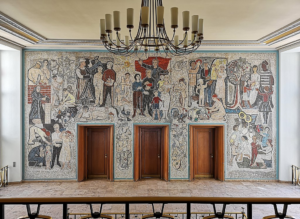 Displacement may not be a familiar headline in conservation circles, but the latest issue of Context, No 162, themed around new towns, includes Michael Asselmeyer’s important exploration of post-war new towns in Germany and how the arrival of millions of displaced people during and after the second world war prompted the building of the first generation of post-war new towns there.
Displacement may not be a familiar headline in conservation circles, but the latest issue of Context, No 162, themed around new towns, includes Michael Asselmeyer’s important exploration of post-war new towns in Germany and how the arrival of millions of displaced people during and after the second world war prompted the building of the first generation of post-war new towns there.
image: Mosaic Mural by Walter Womack at Rathaus Eisenhu?ttenstadt – Peter Kersten [CC BY-SA 4.0 (https://creativecommons.org/licenses/by-sa/4.0)]
For your first IHBC CPD boost of the 2020s, perhaps consider – alone or with colleagues – where displacement shapes any issues for your local heritage and its conservation.
Michael Asselmeyer writes:
It is not widely known in the UK that approximately 12 million displaced people arrived on the territory of present-day Germany between 1944 and 1948. They were Germans who had fled or been expelled from East Prussia, Pomerania and Silesia when they were annexed by the Soviet Union and Poland; from Sudetenland in the western half of Czechoslovakia; and from the Baltic and the Balkans.
Their instant need of housing posed a gargantuan logistic challenge as the cities lay in ruins and could hardly provide shelter for the existing population. Many ammunition factories and barracks built to house forced labourers during the second world war (over six million in 1944) were turned into refugee camps and became the nuclei for the first generation of post-war new towns in Germany, the so-called Vertriebenenstädte und -gemeinden (‘towns and communes for the expelled’).
One of the new towns for expellees is Espelkamp in the state of North Rhine-Westphalia (NRW), formerly in the British Zone…..
A different type of new town, but of similar age, is manifest in the cities planned to serve industrial plants. Wolfsburg, home of the Volkswagen and arguably the most famous, successful, and largest 20th-century new town in Germany, had been founded in 1938 under Nazi rule, but it still deserves its place among post-war new towns. The factory had to be largely rebuilt after the bombing and of the originally planned town (for a population of up to 90,000), no more than 3,000 homes had been built by the end of the war. The original plan by Peter Koller had been based on garden-city and modernist principles, albeit with concessions to Nazi monumentalism; it was abandoned in favour of the 1948 plan by Hans Bernhard Reichow, who later became known for his publication Die Autogerechte Stadt (Automotive City, 1959)…..
Eisenhu?ttenstadt (literally ‘Ironworks Town’) had been founded in 1950 as the GDR’s socialist model city. It was named Stalinstadt until de-Stalinisation led to its re-naming in 1961.
A proposed modernist master plan by Bauhaus architect Franz Ehrlich had been rejected in favour of the Stalinist design (socialist classicism) by Kurt Walter Leucht, which implemented the 16 Grundsätze des Städtebaus (‘Sixteen Principles of Urban Design’, issued by the government of the GDR)…..
Like Espelkamp and Wolfsburg, Eisenhu?ttenstadt is its own ‘lower’ conservation authority, with its town hall and many of its industrial, public and residential buildings enjoying listed status. Covering 230 acres, the original part of the new town has become the largest monument in Germany and attracts funding for its upkeep. The new town extensions, on the other hand, have seen the demolition of over 6,000 homes between 1990 and 2014. The German weekly Der Freitag once published an article by Wolfgang Kil about the struggling new town under the heading ‘the difficult monument’ (Das schwierige Denkmal, 4 January 2008). Kil referred to a local planner’s concern about the limits of listing: ‘We can’t turn every day-nursery into a museum of the GDR’…..
Germany has seen examples of large-scale town planning in later years, such as the 1972 Munich Olympic Village, but these have not reached the level of communal autonomy of the early new towns. In Espelkamp, Wolfsburg and Eisenhu?ttenstadt the local authorities keep the list of protected monuments, and exercise control over their own heritage, supporting a more holistic approach to protect the character of the new towns.
View the full article
For more background see the NewsBlog
 Reading Context helps IHBC members develop their skills across all of the IHBC’s Areas of Competence, and so is a critical baseline in addressing priorities in Continuing Professional Development (CPD)
Reading Context helps IHBC members develop their skills across all of the IHBC’s Areas of Competence, and so is a critical baseline in addressing priorities in Continuing Professional Development (CPD)
To access Context:
- IHBC Members: See your postbox, if you don’t already have it by your desk or bed
- Non-members: Go to the Context Archive
If you have any suggestions for Context articles or other material contact Mike Taylor at: editorial@ihbc.org.uk
See information on Context’s future issues, guidance for authors
Access the online archive
See more IHBC background and guidance on IHBC CPD and on how you might use past, current and future issues of Context
See the formal guidance paper on IHBC CPD(scheduled for update)
See more on the IHBC Competences and Areas of Competence
